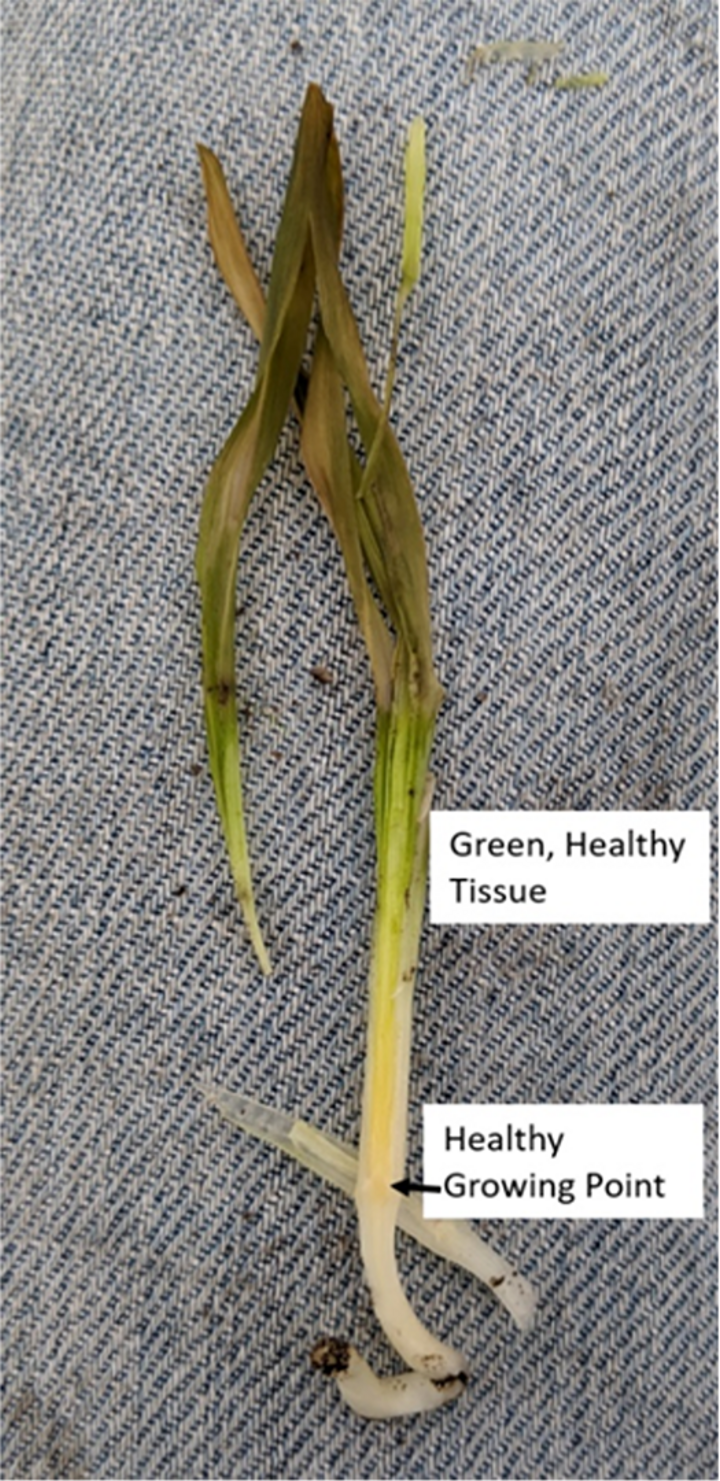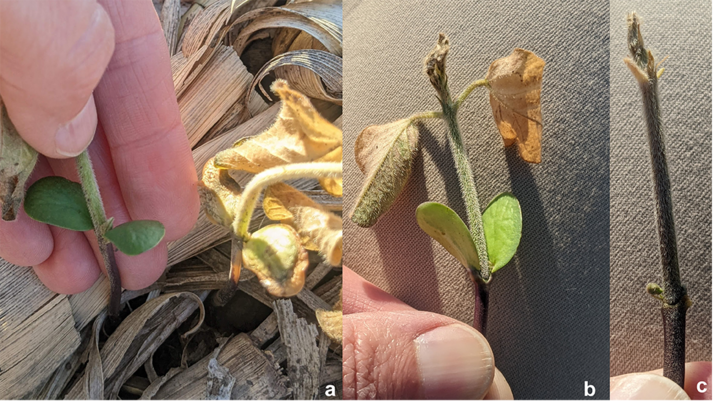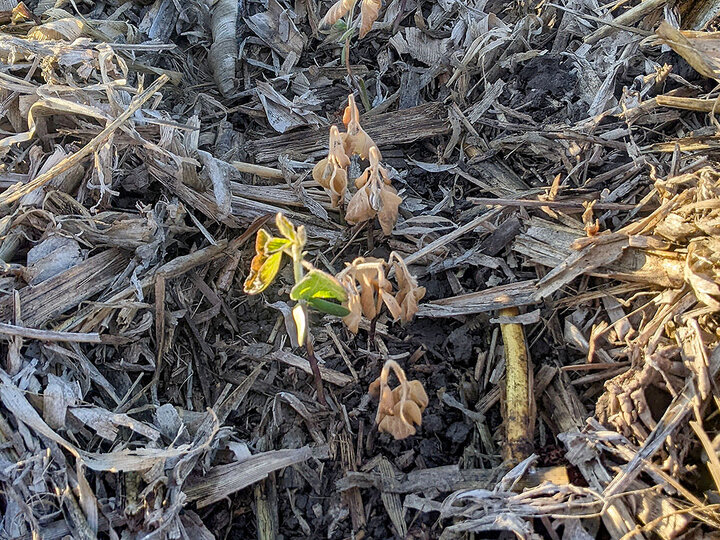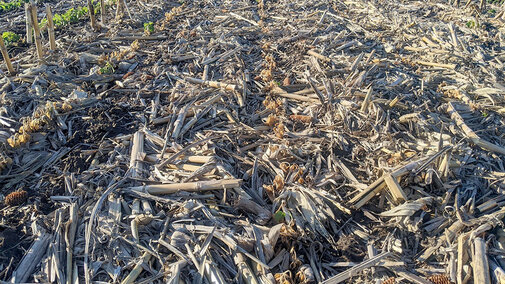This past week was a tough one for some crops in Nebraska. Crusting, hail, wind and frost damage were observed throughout the state. When damage occurs, it may be necessary to evaluate the field to make plant recovery or replant decisions. The following are considerations when performing these assessments.
Key Points
- After a damaging event, five to 10 days are needed before recovery can be fully assessed.
- If damage occurs prior to V5-V6, the corn growing point is below ground, allowing corn the opportunity to recover. Split stems to assess for a healthy growing point.
- Soybean has additional growing points at the axillary buds. If damage occurred below the cotyledons, the plant will die. If above the cotyledons, check for new growth at axillary buds.
- Soybean will compensate for reduced stands. Even large gaps in one row can be compensated by plants in rows on either side.
Plant Damage
1) Wind Damage to Corn and Soybeans
Some fields have corn plants with burnt leaves that appear to be very dry. There has been much wind damage from the amount of soil moving, including ridges of dirt covering plants and plants being “blasted” by the soil. Some plants have even been cut off near ground level. Unfortunately, soybean plants cut off below the cotyledon won’t recover. Corn and soybean plants in fields with standing stalks or other types of residue protection were better protected from windy conditions and may be fine.
2) Freeze and Hail Damage to Corn
Hail and freeze damage on corn can cause exposed leaves to be damaged. Fortunately, until V5-V6, the growing point is below the soil and the corn should recover. The damaged leaves will dry and, as regrowth pushes through, the damaged leaves should blow away in the wind. However, wrapping can occur, so fields should be monitored.
3) Freeze and Hail Damage to Soybean
Soybean is in a variety of stages throughout the state. There have been reports of more soybean planted prior to or at the same time as corn than in previous years. Typically, freeze damage isn’t an issue until air temperatures of 32°F or less are reached. This year, most damage has occurred in low areas of fields with heavy residue. This may seem counterintuitive, but because of cool conditions this spring, soils were at lower temperatures heading into the frost. The plants in the heavy residue areas have more buffered soil temperatures and conditions, but the temperature wasn’t as warm as in the bare soil areas. The bare soils may have released more heat to the atmosphere around the plants, allowing them to fare better this year.

Assessing Recovery
For crop damage situations, waiting five to 10 days helps when assessing regrowth potential. The rain and cool nights that have been experienced throughout the state will delay regrowth, so at least seven days may be needed before performing a field assessment. Warmer conditions following a storm event can result in a quicker assessment of three to five days.
In assessing corn plants, dig up and then slice open plants to evaluate the growing point. If the growing point is white or cream in color and firm, the plant should survive. In contrast, if the growing point is brownish-colored and mushy, the plant will not likely survive.

For soybean, the most critical point for emerging soybeans is when the hypocotyl hook is exposed at the soil line. The hypocotyl hook is the area of the stem below the soybean cotyledon. Anything that impacts it will result in seedling death. Watch for plants that have soft, mushy or pinched hypocotyls. If the cotyledons were exposed, they are actually somewhat frost tolerant since they are 95% water and fairly thick, so low temperatures are needed for an extended period of time to cause damage. Soybeans can survive the cotyledons being stripped and/or burnt off.
In situations where soybean unifoliate leaves were unfurled, all of the potential growing points are above ground so damage could occur. However, the key word in this last statement is growing points, as there are more than one. So, even if low temperatures damage the stem tip, there are still two more growing points where the cotyledons attach that the soybean could regrow from. While this will set back the plant and cause two stems to form, there is no need to replant if these growing points remained viable.
Replant Considerations
Table 1 shows relative yield potential of corn by planting date and population from Iowa State University by Roger Elmore and Lori Abendroth. This is the standard for consideration regarding populations and replant. This illustrates that planting date will have more impact on potential yield than adjusting planting populations. For decisions regarding when to switch from full to lower relative maturity corn hybrids based on your field location, visit this website.
| Population (Plants/Acre) | Planting Date April 20–May 5 % Max Yield | Planting Date May 5–15 % Max Yield | Planting Date May 15–25 % Max Yield | Planting Date May 25-June 5 % Max Yield | Planting Date June 5–15 % Max Yield |
|---|---|---|---|---|---|
| 45,000 | 97 | 93 | 85 | 68 | 52 |
| 40,000 | 99 | 95 | 86 | 69 | 53 |
| 35,000 | 100 | 96 | 87 | 70 | 54 |
| 30,000 | 99 | 95 | 86 | 69 | 53 |
| 25,000 | 95 | 91 | 83 | 67 | 51 |
| 20,000 | 89 | 85 | 77 | 63 | 48 |
| 15,000 | 81 | 78 | 71 | 57 | 44 |
| 10,000 | 71 | 68 | 62 | 50 | 38 |
|
For example, if there are 25,000 plants per acre and the field was initially planted on April 25 and you cannot replant until May 20, it would be better to leave your present stand, which has 95% yield potential, than to replant on May 20 when the yield potential for a stand of 30,000 would be 86%. Make sure you consider replant costs in your decision. Note: Values based on preliminary Iowa research and modeling; 100% yield potential is estimated to occur with 35,000 plant population and early planting. From: Iowa State University Extension, Corn Field Guide, 2nd edition. CSI 001. 2013. |
|||||
For soybean, we recommend that stands down to 50,000 plants/acre be left, particularly the closer to mid-June we get. That can be difficult, especially when one considers weed control. We now have over 15 years of Nebraska On-Farm Research data showing how soybean compensates for reduced populations with minimal yield impact.
For example, one study in York County looking at soybean seeding rates in 2018 compared 90,000 120,000 and 150,000 seeds per acre. Hailstorms and other factors led to final stands of 60,875, 88,125, and 121,750 plants/acre with yields of 93, 94, and 97 bu/ac, respectively. University of Wisconsin found only a 2 bu/ac yield increase when replanting early soybeans between 50,000 and their optimum stand of 100,000-135,000 plants/acre.


As you assess plant stands, keep in mind that a gap in one plant row will be compensated by plants in the adjacent flanking rows. They will form extra branches to take advantage of the sunlight. Thus, single-row gaps may not be as yield-reducing as you might think, especially in narrower row spacings. It’s being observed that one row was hit hard but there are plants in the adjacent rows. Those situations make for very difficult replant situations and again, we’d say those plants in the adjacent rows will branch and eventually help with obtaining near canopy closure (pending any off-target herbicide damage).
There’s also situations where a number of rows (two to six) with extra heavy residue had significant frost damage. However, the damage isn’t occurring the entire row lengths in fields — it is patchy. Those are also difficult replant decisions. Pull back the residue to assess if any portions of plants or unseen plants were protected under the residue. The history of weed pressure in fields will also be important in assessing replant for these patchy areas.
If one replants at this time of year, it’s best to use a similar maturity as what one started with. Full season maturities can still be used up until mid-June. For stands with less than 50,000 plants per acre, plant a similar maturity into the existing stand; don’t tear out or kill an existing stand, as early planted soybeans have a higher yield potential.
If you find yourself in this situation, consider partnering with Nebraska Extension to conduct an on-farm research study. Simply leave a planter pass of your existing stand, plant into your existing stand for a planter pass, and alternate this across your field. Visit with your local extension educator who can help in this process. Please see this protocol for more information.
References
Rees, Jenny, James Specht, Roger Elmore, Aaron Nygren, Nathan Mueller. May 15, 2020. Soybean replanting considerations. https://cropwatch.unl.edu/2020/soybean-replanting-considerations
Taylor, Megan, Aaron Nygren, Jenny Rees, Jim Specht, Amy Timmerman. May 13, 2020. Evaluating freeze and chilling injury in corn and soybeans. https://cropwatch.unl.edu/2020/evaluating-freeze-and-chilling-injury-corn-and-soybeans

